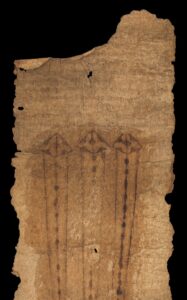Scientists have confirmed that a 500-year-old manuscript in the Wellcome Collection believed to have been worn by women for divine protection during childbirth was indeed used as a “birth girdle” in pre-Reformation England when the postpartum death toll and infant mortality were extremely high.
 Among the relics and talismans seized during the Dissolution of the Monasteries were numerous birthing girdles. Abbeys and monasteries lent them out to parishioners (gross) for a fee that priced most women out of the market. Girdles made of silk, iron, snake skin and parchment are on the lists of confiscated devotional objects from the Dissolution.
Among the relics and talismans seized during the Dissolution of the Monasteries were numerous birthing girdles. Abbeys and monasteries lent them out to parishioners (gross) for a fee that priced most women out of the market. Girdles made of silk, iron, snake skin and parchment are on the lists of confiscated devotional objects from the Dissolution.
Between the destruction of the Reformation, very few birth girdles have survived. Most of them are made of parchment, including the Wellcome Collection manuscript in the recent study. Unusually among surviving girdles, this parchment roll makes the link to childbirth explicit in its prayers that appeal to protective mothers (Mary, Anne). It was made of four strips of vellum sewn together and is incredibly long and thin (10’10” x 4″), a hint of how it may have been worn, for example, wrapped around the body with key prayers placed against the belly for maximum effect.
MS. 632 features iconography of the Passion of the Christ drawn in red and black ink — the crucifix, nails, drops of blood, the I.H.S. Christogram, the five wounds — and prayers and invocations to God, Jesus, Mary and a panoply of Saints, including Anne (mother of Mary), Margaret (swallowed by a demon dragon and burst out of its stomach) and Julitta and Cyricus. Julitta was Cyricus’ mother and according to hagiograhies, they were both martyred in the early 4th century when Cyricus was just three years old. They are the patron saints of family happiness and restoring health to sick children.
The prayers and invocations are written in Latin and English on both sides, although some of the text has been abraded from heavy wear and tear. They seek the protection of God against a variety of evils like being slain in battle, struck by lightning, wrongfully convicted of a crime, robbed at sea or on land and dying of pestilence. Then there’s the specific instructions for use in childbirth:
And yf a woman travell wyth chylde gyrdes thys mesure abowte hyr wombe and she shall be safe delyvyrd wythowte parelle and the chylde shall have crystendome and the mother puryfycatyon. [And if a woman travailing with child girds this measure about her womb, she shall be delivered safely without peril and the child shall be christened and the mother purified.]
It’s childbirth-specific features, abraded surface and a few reddish stains indicated it was likely worn during delivery, but there was no direct evidence. The manuscript is extremely fragile, so in order to confirm whether it was actually used by women during childbirth, researchers at the University of Cambridge turned to that greatest of school supplies, the Staedtler Mars eraser.
This form of non-invasive proteomic analysis has been used before on delicate ancient parchments to determine their animal source, but this is the first time it was used to identify the source of stains on the parchment. The analysis found a total of 54 human-exclusive proteins, 50 of which are present in cervico-vaginal fluid.
They also found animal-derived proteins including honey, milk, eggs, cereals and legumes (broad beans or peas), all of which were are ingredients in herbal treatments for issues in childbirth. Oh, also mouse pee. Plenty of mouse pee, but thankfully that wasn’t part of the delivery pharmacopoeia; just the inevitable result of it being stored somewhere where mice could get to it.
The study has been published in the journal Royal Society Open Science with a pretty great title: Girding the loins? Direct evidence of the use of a medieval parchment birthing girdle from biomolecular analysis.